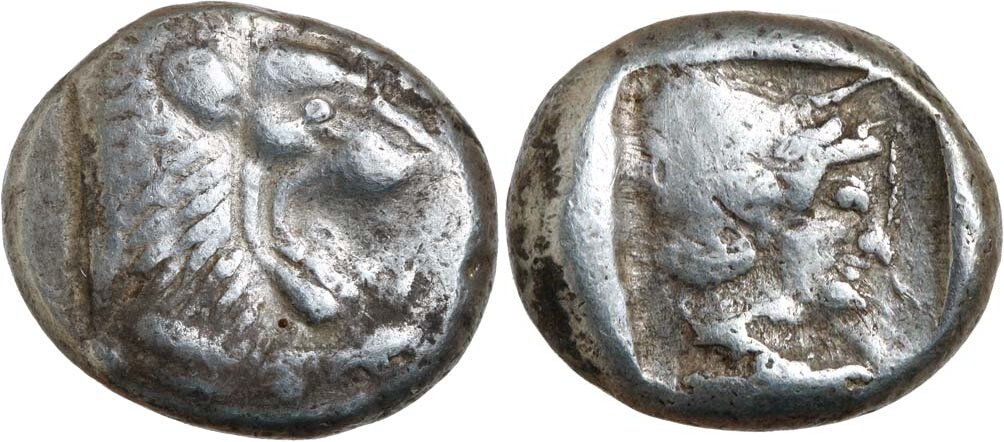Cnidus, silver, drachms (520-495 BCE)
From SILVER
520 BCE - 495 BCE Silver 2,037 kg
Description
| ObverseInscription or printing placed on the obverse.: | Forepart of lion to right with open mouth |
| ReverseInscription or printing placed on the reverse.: | Head of Aphrodite to right of fine archaic style, with hair bound with plain diadem, all within incuse square |
Mint and issuing power
| MintIdentifies the place of manufacture or issue of a numismatic object.: | Cnidus | Ancient regionAncient region.: | Caria | Modern countryModern country: Turkey | AuthorityIdentifies the issuing power. The authority can be "pretended" when the name or the portrait of X is on the coin but he/she was not the issuing power. It can also be "uncertain" when there is no mention of X on the coin but he/she was the issuing power according to the historical sources: |
Chronology
| FromIdentifies the initial date in a range assigned in a numismatic context. | 520 BCE | toIdentifies the final date in a range assigned in a numismatic context.. | 495 BCE | PeriodTime period of the numismatic object.: Archaic until 480 BC |
Physical description
| MetalThe physical material (usually metal) from which an object is made.: | Silver |
Median weightMedian of the weights of numismatic objects (in grams). in grams | 6.20 | DenominationTerm indicating the value of a numismatic object. Examples: tetradrachm, chalkous, denarius.: | drachma |
StandardStandard.: |
Image

AC236 Cnidus 520.jpg [1]
References
| Die study referencePublication of the study: | Cahn 19701Cahn 1970 | ||
| Coin series referenceReference to coin series study: | Sear II2Sear II, n° 3543-3544, RQEMAC3RQEMAC, n° 236 | ||
| Coin series web referenceCoin series web references: | |||
Obverse dies distribution
| FrequencyFrequency of specimen in distribution. ᵖ | Number of obversesNumber of obverse dies. ᵖ (o) | % (o) | Number of coinsNumber of coins. (n) | % (n) | Die nameName(s) of the die(s). |
| 2 | 4 | 25 | 8 | 5.63 | 12, 21, 22, 23 |
| 3 | 1 | 6.25 | 3 | 2.11 | 16 |
| 4 | 1 | 6.25 | 4 | 2.82 | 18 |
| 6 | 1 | 6.25 | 6 | 4.23 | 14 |
| 7 | 3 | 18.75 | 21 | 14.79 | 13, 15, 17 |
| 9 | 1 | 6.25 | 9 | 6.34 | 20 |
| 10 | 1 | 6.25 | 10 | 7.04 | 26 |
| 11 | 1 | 6.25 | 11 | 7.75 | 24 |
| 16 | 1 | 6.25 | 16 | 11.27 | 19 |
| 20 | 1 | 6.25 | 20 | 14.08 | 27 |
| 34 | 1 | 6.25 | 34 | 23.94 | 25 |
| Total | 16 of 16 | 100 | 142 of 142 | 100 |
Reverse dies distribution
no distribution is available
Quantification
| Number of obversesNumber of obverse dies. ᵖ (o) | 16 | Number of singletons (o1)The number of singleton coins. ᵖ | |
| Number of reverse diesNumber of reverse dies. (r) | 15 | Number of coinsNumber of coins. (n) | 142 |
| Coins per obverse dieNumber of coins per obverse die. (n/o) | 8.88 | Coins per reverse dieNumber of coins per reverse die. (n/r) | 9.47 |
| Reverse per obverse ratioRatio of obverse dies divided by reverse dies. (r/o) | 0.94 | Percentage of singletons (o1)number of coins (n) divided by the number of singletons (o1) ᵖ | % |
| Original number of dies (O) (Carter 1983 formula)The estimation of the number of coins according to Carter 1983 ᵖ | 16.43 | Coins struck if 20,000 as average productivity per dieCoins made if the average productivity for obverses (according to Carter) is 20,000. ᵖ | 328,600 |
| Original number of dies (O) (Esty 2011 formula)The estimation of the number of coins according to the singleton formula in Esty 2011 ᵖ (O) | 18.03 | Survival rate if 20,000 as average productivity per dieSurvival rate if average productivity is 20,000. ᵖ | 0.00043 |
| Coverage (o = % of O) (Esty 1984 formula)Esty 1984 - coverage (% of O) ᵖ (o = % of O) | % | Die productivity if survival rate 1/2,000Average productivity if survival rate is 1/2,000. ᵖ | 17,285.45 |
| Weight of silver (in kg) if 20,000 coins per die (O = Carter formula)Carter 1983 * Median weight * 20000 (*10 if gold or electrum) ᵖ | 2,037 kg <br /> 2,037 kg | Die productivity if survival rate 1/5,000Average productivity if survival rate is 1/5,000. ᵖ | 43,213.63 |
Remarks